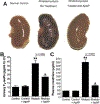The Role of Circulating Cell-Free Hemoglobin in Sepsis-Associated Acute Kidney Injury
- PMID: 32303278
- PMCID: PMC7172012
- DOI: 10.1016/j.semnephrol.2020.01.006
The Role of Circulating Cell-Free Hemoglobin in Sepsis-Associated Acute Kidney Injury
Abstract
Sepsis is a heterogeneous clinical syndrome that is complicated commonly by acute kidney injury (sepsis-AKI). Currently, no approved pharmacologic therapies exist to either prevent sepsis-AKI or to treat sepsis-AKI once it occurs. A growing body of evidence supports a connection between red blood cell biology and sepsis-AKI. Increased levels of circulating cell-free hemoglobin (CFH) released from red blood cells during hemolysis are common during sepsis and can contribute to sepsis-AKI through several mechanisms including tubular obstruction, nitric oxide depletion, oxidative injury, and proinflammatory signaling. A number of potential pharmacologic therapies targeting CFH in sepsis have been identified including haptoglobin, hemopexin, and acetaminophen, and early phase clinical trials have suggested that acetaminophen may have beneficial effects on lipid peroxidation and kidney function in patients with sepsis. Bedside measurement of CFH levels may facilitate predictive enrichment for future clinical trials of CFH-targeted therapeutics. However, rapid and reliable bedside tests for plasma CFH will be required for such trials to move forward.
Keywords: Sepsis; acetaminophen; acute kidney injury; biomarkers; cell-free hemoglobin; hemolysis.
Copyright © 2020 Elsevier Inc. All rights reserved.
Conflict of interest statement
Conflict of interest statement: Dr. Ware reports consulting fees from CSL Behring, Bayer and Quark Pharmaceuticals as well as a research contract with CSL Behring (current) and past research contracts with Boehringer Ingelheim and Global Blood Therapeutics, all unrelated to the current manuscript.
Figures



References
-
- Hall MJ, Levant S, Carol JD Trends in Inpatient Hospital Deaths: National Hospital Discharge Survey, 2000–2010. Hyattsville, MD: National Center for Health Statistics; 2013. https://www.cdc.gov/nchs/products/databriefs/db118.htm. Accessed September 15, 2019.
-
- Angus DC, Linde-Zwirble WT, Lidicker J, Clermont G, Carcillo J, Pinsky MR. Epidemiology of severe sepsis in the United States: Analysis of incidence, outcome, and associated costs of care. Crit Care Med. 2001;29(7):1303. - PubMed
Publication types
MeSH terms
Substances
Grants and funding
LinkOut - more resources
Full Text Sources
Medical
Miscellaneous

